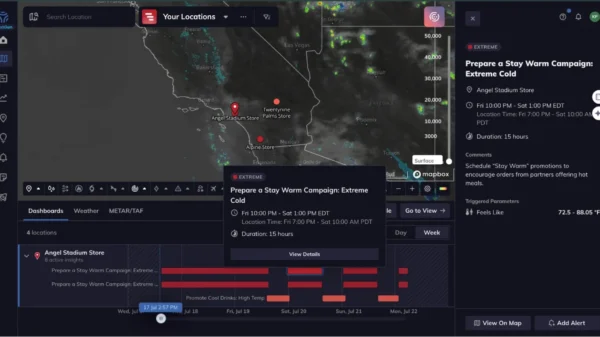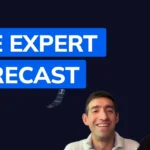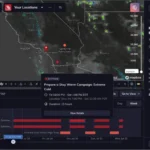Weather can have a significant impact on business operations and outcomes. Organizations that take a proactive approach to managing weather disruptions can gain a competitive advantage.
When you understand your business’s ultimate goals and how weather impacts the ability to meet those goals, you can utilize predictive analytics, weather data, and the power of automation and weather intelligence to improve business outcomes.
Bill Claflin, Director of Sales at Tomorrow.io, provides valuable perspectives on how companies can align around weather data to optimize planning. In a recent interview with Bill, we discussed how businesses can leverage weather data to drive better business outcomes and make more informed decisions. Below are his insights.
Beyond Forecasts: Understanding the Business Impact of Weather Events
While tracking weather forecasts is important, Claflin notes that organizations need to go a step further. Focusing solely on the forecast itself is not enough. Businesses must also consider the downstream impacts weather will have on regular operations and planned outcomes.
For example, how will a forecast affect safety, efficiency, productivity, and meeting customer expectations over a day or week? Will it change in real-time?
Leaders need to understand these potential disruptions when assessing a forecast and have protocols in place for how they should react to specific high-impact events.
“As an organization, you not only need to stay on top of what is a changing weather forecast or multiple different weather forecasts. But you also need to understand how those forecasts are going to ultimately impact your organization’s regularly scheduled programming,” Claflin explains.
Looking at a weather forecast and being able to identify what the weather is, where those events are occurring, the severity of them, their frequency, and then communicating that information is table stakes when it comes to keeping employees and communities safe.
Business leaders need to look beyond the forecast and the weather details if they want to make positive changes and smarter decisions in their weather adaptation processes.
Where companies are beginning to move toward is “understanding the downstream effect of that weather impact” on business outcomes. If you’re planning for X, you need to know how high-impact weather could impact the ability to deliver on X based on real-time weather data. Then, you can build toward a fully integrated business and operational plan around those events.
Business Problems: How Manual Weather Interpretation Opens the Door for Error
You would think that a large organization would have the ability to build out proper weather protocols and early warning systems, but that’s just not the case. Large companies tend to face similar challenges in struggling to adapt at scale while relying on manual weather interpretation.
Claflin’s opinion is that relying on human beings to gather and interpret weather data and weather forecasting manually leads to unnecessary risks. Manually evaluating weather forecasting against business decision criteria is precarious. With people behind the process, businesses are vulnerable to potential errors, miscommunications, and missed opportunities.
“Any time you put human beings and data in the same context and you’re having them decide against sets of data, that just leaves the door open for human error in general,” he says. Weather events or nuances can be overlooked. Decisions might be suboptimal. Critical communication about forecasts may not happen quickly enough.
The bottom line is that manual interpretation injects uncertainty into weather planning processes. Companies expose themselves to operational risks since executing the business plan becomes reliant on people accurately assessing complex, constantly changing weather conditions.
Opportunity Cost: The Price of Reactive Weather Planning
So, what are the implications when organizations don’t have proper weather risk intelligence in place?
Claflin notes that there are two primary downsides – risks from inaction and opportunity costs.
First, without accurate weather insights that provide enough advanced warning, businesses can’t take proactive precautions to mitigate risks and need to react manually. Claflin points out, “There’s risk associated with that, and that risk could manifest in a million different forms, including not executive against your business plans.”
Any business function dependent on certain weather conditions could be affected by a lack of automation. “Whether your business plan is to remain safe, remain productive, or keep your customer commitments, there’s always a risk when you’re manually interpreting data.” Manual processes mean risks go undetected until conditions have already deteriorated.
Second, companies without advanced weather capabilities lack opportunities to differentiate from competitors. “If I’m not managing weather as well as I can, or I guess better put, if you look at your competitor, they are likely managing weather the traditional way, which is probably reactive, right?” If you can understand how weather is going to impact the outcomes that you care about adversely, you are suddenly more efficient than your competitor. You’re upholding customer promises while they are not.
Companies that leverage weather insights to avoid disruptions can gain an advantage through greater efficiency, productivity, and safety.
Weather Intelligence Aligns Safety and Operations Groups
Claflin discusses how having a centralized weather intelligence platform helps align different stakeholders within an organization. Groups like safety managers and operations leaders may have different priorities but share a common goal of optimizing business outcomes.
For a construction firm, safety managers want to minimize risks across work sites. Operations supervisors aim to maximize productivity and meet deadlines. A shared weather platform allows both teams to understand forecasted risks and adjust operational plans accordingly. Safety precautions remain in place, while operations can adapt to optimize workflow.
“If you’re a superintendent on a job site, you’re interested in moving as fast as humanly possible. If you want to be able to meet that deadline, you obviously don’t want to sacrifice safety, but your goal is productivity. And, if you’re an operations leader using the platform, you can get aligned with safety and understand, ‘where are these risks that are going to occur across a given day’?
As Claflin explains, “You’ve got these two separate groups within the organization using the same platform, driving towards the same goal, but the goals are a little bit different.” Alignment improves when groups can collaborate using a centralized platform rather than make decisions in isolation based on their narrow focus area.
How Proactive Customer Communication Builds Relationships
Weather intelligence platforms empower businesses to take a more proactive approach to customer communication as well. Claflin highlights an example in the logistics industry. A company leveraged weather insights originally just to keep employees safe in customer yards. However, the scope expanded to improved coordination with customers around potential weather disruptions.
With advanced warning of conditions that may impede operations, the logistics provider could give customers far more notice of delays or limitations. As Claflin notes, this allowed them to “better explain these disruptions to their customers.” Instead of showing up unable to complete work as promised, they could outline in advance how real-time weather data would impact that day’s schedule and productivity.
This kind of proactive communication and coordination with customers ultimately strengthens business relationships. Customers have greater confidence when providers show foresight into preventing weather disruptions rather than appearing caught off guard and unreliable.
Key Takeaways
In summary, Claflin provides several key lessons for leveraging weather intelligence to enhance business outcomes:
- Look beyond weather forecasting to understand downstream impacts on operations and goals
- Reduce reliance on manual interpretation that often leads to error and missed opportunities
- Mitigate risks and realize competitive advantages by applying weather insights proactively
- Use a centralized platform to align groups with different priorities and focuses
- Strengthen customer relationships by taking a proactive approach to communications
- Businesses across retail, rail, construction, aviation, outdoor events, and much more can leverage accurate weather forecasts for business planning
For organizations in weather-sensitive industries, integrating and acting on accurate forecast data can create tremendous value. But as we emphasized, it is essential to go beyond raw weather information and focus on aligning around business outcomes.
When weather intelligence provides the full operational context, companies gain agility to optimize performance.
To learn more about how weather intelligence can support your business alignment, schedule a demo today.






